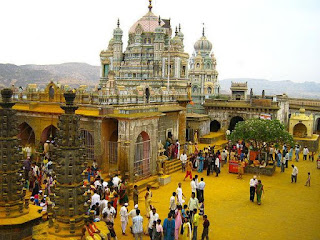Top 5 Amazing Pilgrimage in Maharashtra
Maharashtra is one of the most popular destinations in India, on the western and western Ghats of The Arabian Sea, on the land of the Marathas. India's third-largest state is blessed with beauty, culture, history, adventure and more. Known as a wonderful natural beauty and rich cultural heritage,
Maharashtra is the most industrialized state in India. This charming beauty has beautiful beaches as well as some of the most beautiful hill stations, pilgrimages, forts, ancient caves in Maharashtra. There are also the Western Ghats, a World Heritage Site, national parks, and wildlife sanctuaries, to blend in with awe-inspiring beauty. The variety of things to do, the wonderful things to do, and the views are confusing, so given below you help list the top vacation destinations in Maharashtra that you must visit:
1. Trimbakeshwar Temple
(Nashik, Maharashtra)
 |
| Trimbakeshwar Temple |
In 1755-1786 AD, the Trimbakeshwar Temple was built by Shri Nana SahebPeshwa. The Jyotirlinga, located here, is the embodiment of its three faces- Lord Brahma, Lord Vishnu, and Lord Rudra. At the top of this Linga is a crown full of precious stones, which is said to have been from the time of the Pandavas. The crown is beautified with various precious stones such as emeralds, diamonds and many other varieties and this crown is shown each Monday from 4 PM to 5 PM. This temple is built of black stone in the civic style of architecture and is enclosed in a roomy patio. In the sanctum, there is a small Shivalingam- Trimbaka in the inner square and outside in stellar compositions. The sanctum sanctorum is crowned with an elegant tower, adorned with a huge Amalaka and gold kalasha. The whole design is a sculpture, a beautifully crafted work with moving scrolls, floral designs, and figures of gods, yakshas, humans, and animals. Before the garbagriha and the antarala is a mandap with entryways on every one of the four sides and water flows continuously from the peak of Shivlinga.
According to legend, Trimbakeshwar was the place of ‘Tri- Sandhya Gayatri’ where Lord Ganesh was born. It is believed that Trimbakeshwar was the residence of the venerable Rishi Gautam. Gautama to get mitigated of the sin of Gohatya worshipped Lord Shiva at Brahmagiri Mountain for the down- a progression of River Ganges. The will was granted and the Goddess Ganga took the form of the Godavari river and originated from the Kushavarta of the Brahmagiri mountain. It is said that whoever visits Trimbakeshwar receives salvation. Kushavarta, a sacred lake in the temple area, is the source of the Godavari River, the longest river in the peninsula. Brahmagiri, Gangadwar, Parashuram Temple, Caves of 108 Shivalingams, Indra Tirtha, Ahilya Sangam Tirtha, Bilwa Tirtha, and Gautama Tirtha are places that can be visited at Trimbakeshwar. There are many ashrams in the art of Hindu living, Ashtanga Yoga. This Pilgrimage is also famous for religious rituals like Narayan Nagbali, Kalasarp Shanti, Tripindi ritual, etc.
Temple Opening Time: 5:30 AM to 9 PM
Entry Fees: No Entry Fees
Duration: 1 to 2 Hrs
Entry Fees: No Entry Fees
Duration: 1 to 2 Hrs
2. Jejuri Temple
(Tehsil Purandar- Pune, Maharashtra)
3. Saptashrungi Devi Temple
(Nashik, Maharashtra)
 |
| Saptashrungi Devi Temple |
Saptashringi Devi Temple (Vani) is located 60 km from Nashik in the state of Maharashtra. According to tradition, the Goddess Saptashrungi Nivasini lives within the top of the seven mountains. And the Sapta implies seven and the shrung is peak. This temple is situated in Nanduri, Kalwan taluka, a little town close Nashik in India. The Saptashrungi Devi Temple is an important part of the "three and a half Shaktipeeth" (seat of the Hindu Goddess) in Nashik. The temple is also among the 51 Shakti Peethas situated in the Indian subcontinent and is where one of Sati's (Lord Shiva's wife) appendages, her right arm is accounted for to have fallen. This is half shaktipeeth of the three and a half Shaktipeeth in Maharashtra.
The goddess of the temple took the form of a Durga to kill Mahishasura, the buffalo demon who had a difficult time in the universe. After that battle, the goddess settled here and a sanctum has been built that is closed to public viewing in that space. The Saptashringi Devi is decorated with valuable stones and cloak which have been giving by devotees as a thanksgiving offering. There are 500 steps to the temple which has a community hall and a gallery for the devotees to stand in the queue. Throughout the year, a large number of devotees visit this place all over India. A mountainous area, the temple will offer some stunning views of the landscape surrounding the temple. There will be a facility to reach the temple or temple using funicular trolleys ropeway soon at the temple of the Saptashrungi Devi. At the beginning of the temple, the temple administration is now appearing live online darshan and the live stream is available for free.
Temple Opening Time: 6 AM to 9 PM
Entry Fees: No Entry Fees
Duration: 2 Hrs
Temple Opening Time: 6 AM to 9 PM
Entry Fees: No Entry Fees
Duration: 2 Hrs



Comments